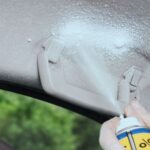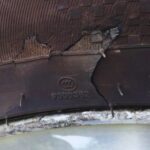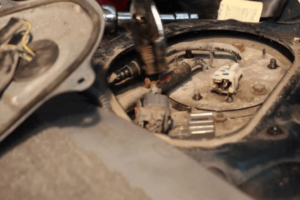Getting bullet holes on your car is one of the worst types of damage that it can sustain. Not only does it ruin the look of your car, but it also raises too many questions about how you got your car shot in the first place. So, if you want to avoid attracting unwanted attention, you need to know what to do when you get bullet holes in a car – how to repair them, and the costs you might incur in the process.
Repairing bullet holes in your car is not different from fixing any other kinds of holes and small dents in a vehicle. The basic steps are applying filler, shaping, smoothing, priming, and painting. It’s not that difficult and would cost you next to nothing compared to taking it to an auto shop to be fixed.
However, fixing it also all boils down to the size of the bullet hole. You can fix some holes easily, while some require a more extensive process.
Read on to learn more about how to repair bullet holes in cars.
Bullet Holes in Car – How to Repair

Repairing bullet holes in your vehicle is somewhat similar to fixing any other kinds of holes and small dents in a vehicle. The basic steps include applying filler, shaping, smoothing, priming, and painting.
It’s quite easy, especially if you have experience in repairing cars. It would most likely cost you next to nothing compared to taking it to an auto shop to be fixed.
However, fixing it also depends on the size of the bullet hole. Some bullet holes can be fixed easily, while some require a more extensive process.
Bullet Hole’s Size
Before you start filling in the bullet holes in your car, you need to take a look at how big they are. If the bullet holes are large, you will first have to pound it flat. Then, spot weld a patch on the metal’s back before applying the filler.
If the bullet hole is small, you can pull them out using a slide hammer. Work the metal flat afterward, and then commence to apply the filler in the holes.
How to Repair Bullet Holes in Car – A Step by Step Guide
Here are the steps on how to repair bullet holes in a car:
- Buy a Body Filler Kit
- Clean and Sand the Body Area
- Mix and Apply the Filler
- Shape, Smooth, Prime, and Paint
1. Buy a Body Filler Kit
There are several products available on the market used for filling dents, creases, and small holes on the surface of your vehicle. These body filler kits usually come with at least two substances. These include the filler itself and the hardener that you should mix with the filler before using it.
Choose a Filler with the Easiest Instructions
When buying a body filler kit, make sure to choose one with the easiest-to-follow instructions. That way, you can accomplish the task with a minimum of fuss. Some products are intended for repairing sheet metal, such as filling in holes and other punctures. They can also even out areas on a car’s body panel before priming and painting.
2. Clean and Sand the Body Area
Before applying the filler to the holes, you must thoroughly clean the body area first. Next, sand the area using either a #180 or #220 aluminum oxide sandpaper. You may also use any sandpaper that effectively works on the plastic or aluminum parts of your car.
You may also use a Scotch-Brite pad. Scrape the area around the bullet hole, then blow off the sanding dust.
Sanding Prevents the Body Fillers from Sticking to Paint
Sanding the area is especially important as body fillers don’t stick to paint. Make sure to feather-edge or blend the paint edges when sanding. That way, you can achieve a good bond. Also, you can keep the old paint from chipping through the new one in the future. Work gently inward from the dent’s edges so as not to further enlarge the damaged area.
Again, how to repair bullet holes in cars? Repairing a car riddled with bullet holes is easy and won’t cost you much. The steps involved include applying filler, shaping, smoothing, priming, and painting.
3. Mix and Apply the Filler
After the body area has been thoroughly cleaned and sanded, start mixing the filler with the hardener. Be sure to follow the instructions in the kit. Mix only as much of the hardener-filler mixture as you intend to use right away. Then, stir it until it becomes a uniform color.
Hold the Filler in Place
When you’re patching a hole, place something underneath it to hold the filler in place. You can place either fiberglass screening or fine aluminum chicken wire under the hole. This works in the metal portion of the body. Make sure to place it precisely on the underside of the body.
For holes in the plastic or fiberglass part, use the suitable patch kit. You can buy this from your local auto supply or auto paint store.
Apply the Mixture to the Screen’s Edges
Apply the filler and hardener mixture to the screen’s edges. Also, apply it on the edges of the area to be patched to hold the screen in place. If the kit doesn’t contain an applicator, use a putty knife to apply the filler. You may also use a scraper as an option. Leave the screen patch to dry for several hours.
Use a Plastic Squeegee When Applying the Filler to the Bullet Hole
Once the screen patch has dried, apply the filler to the bullet hole using a plastic squeegee. Work carefully and slowly. That way, you don’t spread the filler outside of the hole and mar the surrounding area.
Use spring steel to even out the surface and remove excess filler. When done, the filled surface must be somewhat higher than the surface of the car surrounding it.
4. Shape, Smooth, Prime, and Paint
Use a Sun or Heat Lamp for Drying
Harden the filler using a sun lamp or heat lamp. Wait for the filler to harden to about the consistency of hard cheese. Then, scrape it down with a perforated file to bring it down to about the level of the paint.
Wait at Least 30 Minutes for the Hardener to Dry
Wait for at least 10 to 15 minutes, or 20 to 30 minutes at the most, until the filler has become bone dry. Then, use medium-grain sandpaper to sand over the area until it perfectly conforms with the body surface around it. While sanding, keep checking the hardened filler for high and low spots and apply additional filler if necessary.
Use the Primer to Cover up Tiny Holes
Once everything has been smoothed and evened-up, what comes next is priming the filled-in area. The primer can be used as a last layer of filler to cover tiny holes and other minor inconsistencies.
Apply Several Layers of the Primer
Apply several layers of primer, then sand each layer using a sanding block until the area becomes perfectly smooth. To ensure that it has smoothened, wet the primer and observe how the light reflects off its surface.
Touch up the Paint
After the primer has dried completely, all left is to touch up the paint, which should be easy enough to handle from here. Just spray paint the repaired area with the color that matches the rest of the car. Apply at least two coats, but be careful that you don’t cause a run from overpainting.
Can You Drive Without a Front Bumper?
How Much Does It Cost to Repair Bullet Holes in Car?

If you know how to repair bullet holes in a car on your own, it would only cost you the price of the tools, body filler, and paints that you would need. But if you decide to get it fixed at a shop, it will depend on certain things, such as the size of the bullet holes.
For instance, small holes can range from around $60 to $110. At the same time, the larger ones can cost you from $100 to $130.
Exterior paint chip repair could cost you around $50 to $300, depending on the paint and the needed amount. Other factors include the following:
- Labor costs,
- Length of time to repair,
- Model of your car, and
- Extent of the damage.
It’s one thing if only the surface of the car is damaged. But if other parts of the vehicle, such as the seats, airbags, or the car computer, have also sustained bullet holes, your repair bill could surge up as high as $5,000.
Are Bullet Holes Covered by Car Insurance?
Fortunately, car insurance does indeed cover bullet holes. However, your insurance company may or may not be able to cover bullet holes depending on the kind of coverage.
It is required in most states to have a minimum amount of car insurance coverage to drive legally. This would usually allow you a minimum amount of liability coverage. In this case, liability would only cover damages you inflict on someone else and their vehicle by accident. This means that it won’t cover damages sustained by your car from gunfire.
To cover the costs of repairing the bullet holes in your car, you will need full car insurance, including comprehensive car insurance. This alone covers the cost of bullet hole repairs on your car.
In addition to that, getting full coverage also ensures that your car insurance policy will include liability and collision coverage. So, if your car sustained additional damage caused by collision while getting riddled with bullets, all of that would be well covered.
Why It’s Advantageous to Repair the Bullet Holes on Your Own

Save Repair Costs
The biggest and most obvious advantage of learning to fix the bullet holes on your car all by yourself is, of course, the cost, as we have already discussed above. You end up saving a lot on shop repair costs and insurance by doing things of your ingenuity and spending only on what you need.
Protect Your Privacy
Another advantage is the protection of your privacy. It is, after all, rather dubious for one to have a car shot full of bullet holes. The event itself may have been so traumatic that you do not wish to discuss it any further. But still, you are left open to judgment, and you can’t risk taking your car to a shop without getting people to ask questions.
But if you can repair the bullet holes on your car on your own, you may be able to do so within the privacy of your garage, away from prying eyes. You won’t have to give out explanations that you don’t owe anyone.
Just because you have something to hide, it doesn’t mean that you’re guilty of anything. You’re not covering up a crime, but an unsightly reminder of an unpleasant experience that you would just as soon forget.
Conclusion – Bullet Holes in Car – How to Repair
Repairing bullet holes in your car is somewhat similar to fixing any other kinds of holes and minor dents in a vehicle. The basic steps are applying filler, shaping, smoothing, priming, and painting. It’s not that difficult and would cost you next to nothing compared to taking it to an auto shop to be fixed.
However, fixing it also depends on the size of the bullet hole. You can easily fix some bullet holes, while some require a more extensive process.
The cost to repair bullet holes in a car depends on certain factors, such as the type of vehicle and the amount of damage. But it could end up costing you from as little as $60 to as much as $5,000.
However, if you have the know-how and the right tools, you can fill in those pesky holes in your car at a minimal cost. Also, by taking care of the problem in private, not only do you save a lot of money, but you also save your reputation.
You won’t have to parade your car in the open and get everyone wondering why it’s shot full of holes. Your good name and character will be as clean as your car. Once you’ve successfully covered up all its holes, it will look as pristine as though no untoward incident had ever happened.
Related reading:
How Much Does It Cost to Repaint a Car? [Average Cost]
How Much Does It Cost to Paint a Truck?
High Build Primer [When to Use and Best Automotive High Build Primers]
How Much Do Hydraulics Cost? [Car Hydraulics Price Estimates]



![How Much Does Paintless Dent Repair Cost? [Full Guide] how much does paintless dent repair cost](https://roadsumo.com/wp-content/uploads/2022/05/how-much-does-paintless-dent-repair-cost-150x150.jpg)
![Scratched Rims Repair Cost [How Much to Fix a Scratched Rim?] Scratched Rims Repair Cost](https://roadsumo.com/wp-content/uploads/2021/10/scratched-rims-repair-cost-150x150.jpg)
![How to Fix a Bad O2 Sensor [Oxygen Sensor Repair] How to Fix a Bad O2 Sensor](https://roadsumo.com/wp-content/uploads/2021/10/how-to-fix-a-bad-O2-sensor-150x150.jpg)


![Read more about the article Neo Chrome – Wrap, Paint, Wheels [Full Guide]](https://roadsumo.com/wp-content/uploads/2022/05/neo-chrome-300x200.jpg)